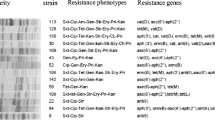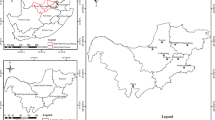Abstract
The properties of 166 environmental strains belonging to the seven enterococcal species were studied. Enterococci originated mainly from surface- and waste-waters. They were screened for the presence of enterocins, virulence factors, and antibiotic resistance. The presence of different enterocin genes (entA, entB, entP, ent31, entL50AB) was frequently observed in our enterococcal isolates, 109 strains contained at least one enterocin gene. The distribution of enterocin genes varied according to the species, the genes were present mainly in E. hirae and E. faecium. By enterocin spot assay, 10 isolates inhibited the growth of Listeria strains. To evaluate the pathogenic ability of isolates, the distribution of selected virulence genes (cylA, gelE and esp) was investigated, eleven strains were positive in some of these genes, five of them belonged to E. faecalis. Regarding the antibiotic resistance of isolates, only two strains were multiresistant and two strains (E. hirae and E. casseliflavus) were resistant to vancomycin.
Similar content being viewed by others
References
Achemchem F, Abrini J, Martínez-Bueno M, Valdivia E, Maqueda M (2006) Control of Listeria monocytogenes in goat’s milk and goat’s jben by the bacteriocinogenic Enterococcus faecium F58 strain. J Food Prot 69:2370–2376
Agerholm-Larsen L, Raben A, Haulrik N, Hansen AS, Astrup A (2000) Effect of 8 week of probiotic milk products on risk factor for cardiovascular disease. Eur J Clin Nutr 54:288–2997. doi:10.1038/sj.ejcn.1600937
Alves PI, Martins MP, Semedo T, Figueiredo Marques JJ, Tenreiro R, Barreto Crespo MT (2004) Comparison of phenotypic and genotypic taxonomic methods for the identification of dairy enterococci. Antonie Van Leeuwenhoek 85:237–252. doi:10.1023/B:ANTO.0000020352.29496.4e
Ananou S, Garriga M, Hugas M, Maqueda M, Martínez-Bueno M, Gálvez A et al (2005) Control of Listeria monocytogenes in model sausages by enterocin AS–48. Int J Food Microbiol 103:179–190. doi:10.1016/j.ijfoodmicro.2004.12.024
Bujdakova H, Krupova I, Filipova M, Benczeova S, Kettner M, Drahovska H et al (2003) The occurrence and transferability of the resistance determinants in 50 amikacin-resistant Enterococcus faecalis and Enterococcus faecium. Int J Antimicrob Agents 22:632–633. doi:10.1016/S0924-8579(03)00247-4
Cintas LM, Casaus P, Herranz C, Havarstein LS, Holo H, Hernandez PE et al (2000) Biochemical and genetic evidence that Enterococcus faecium L50 produces enterocins L50A and L50B, the sec-dependent enterocin P, and a novel bacteriocin secreted without an N-terminal extension termed Enterocin Q. J Bacteriol 182:6806–6814. doi:10.1128/JB.182.23.6806-6814.2000
Chow JW, Thal LA, Perri MB, Vazquez JA, Donabedian SM, Clewell DB et al (1993) Plasmid-associated hemolysin and aggregation substance production contribute to virulence in experimental enterococcal endocarditis. Antimicrob Agents Chemother 37:2474–2477
Clewell DB, Francia MV, Flannagan SE, An FY (2002) Enterococcal plasmid transfer: sex pheromones, transfer origins, relaxases, and the Staphylococcus aureus issue. Plasmid 48:193–201. doi:10.1016/S0147-619X(02)00113-0
Clyne M, Deazavedo J, Carlson E, Arbunthnott J (1988) Production of gamma-haemolysin and lack of production of alpha-haemolysin by Staphylococcus aureus strains associated with toxic shock syndrome. J Clin Microbiol 26:535–539
Cocolin L, Foschino R, Comi G, Grazia Fortina M (2007) Description of the bacteriocins produced by two strains of Enterococcus faecium isolated from Italian goat milk. Food Microbiol 24:752–758. doi:10.1016/j.fm.2007.03.001
Cosentino S, Pisano MB, Corda A, Fadda ME, Piras C (2004) Genotypic and technological characterization of enterococci isolated from artisanal Fiore Sardo cheese. J Dairy Res 71:444–450. doi:10.1017/S002202990400041X
Cupáková Š, Lukášová J (2003) Agricultural and Municipal Waste Water as a Source of Antibiotic-Resistant Enterococci. Acta Vet Brno 72:123–129
De Vuyst L, Foulquié Moreno MR, Revets H (2003) Screening for enterocins and detection of hemolysin and vancomycin resistance in enterococci of different origins. Int J Food Microbiol 84:299–318. doi:10.1016/S0168-1605(02)00425-7
Drahovská H, Slobodníková L, Kocíncová D, Seman M, Končeková R, Trupl J et al (2004) Antibiotics resistance and virulence factors among clinical and food enterococci isolated in Slovakia. Folia Microbiol (Praha) 49:763–768
Dupre I, Zanetti S, Schito AM, Fadda G, Sechi LA (2003) Incidence of virulence determinants in clinical Enterococcus faecium and Enterococcus faecalis isolates collected in Sardinia (Italy). J Med Microbiol 52:491–498. doi:10.1099/jmm.0.05038-0
Eaton TJ, Gasson MJ (2001) Molecular screening of Enterococcus virulence determinants and potential for genetic exchange between food and medical isolates. Appl Environ Microbiol 67:1628–1635. doi:10.1128/AEM.67.4.1628-1635.2001
Ennahar S, Asou Y, Zendo T, Sonomoto K, Ishizaki A (2001) Biochemical and genetic evidence for production of enterocins A and B by Enterococcus faecium WHE 81. Int J Food Microbiol 70:291–301. doi:10.1016/S0168-1605(01)00565-7
Franz CM, Stiles ME, Schleifer KH, Holzapfel WH (2003) Enterococci in foods-a conundrum for food safety. Int J Food Microbiol 88:105–122. doi:10.1016/S0168-1605(03)00174-0
Foulquié Moreno MR, Sarantinopoulos P, Tsakalidou E, De Vuyst L (2006) The role and application of enterococci in food and health. Int J Food Microbiol 106:1–24. doi:10.1016/j.ijfoodmicro.2005.06.026
Heikens E, Bonten MJ, Willems RJ (2007) Enterococcal surface protein Esp is important for biofilm formation of Enterococcus faecium E1162. J Bacteriol 189:8233–8240. doi:10.1128/JB.01205-07
Herranz C, Mukhopadhyay S, Casaus P, Martinez JM, Rodriguez JM, Nes IF et al (1999) Biochemical and genetic evidence of enterocin P production by two Enterococcus faecium-like strains isolated from fermented sausages. Curr Microbiol 39:282–290. doi:10.1007/s002849900460
Ike Y, Clewell DB, Segarra RA, Gilmore MS (1990) Genetic analysis of the pAD1 hemolysin/bacteriocin determinant in Enterococcus faecalis: Tn917 insertional mutagenesis and cloning. J Bacteriol 172:155–163
Jett BD, Jensen HG, Nordquist RE, Gilmore MS (1992) Contribution of the pAD1-encoded cytolysin to the severity of experimental Enterococcus faecalis endophthalmitis. Infect Immun 60:2445–2452
Jett BD, Huycke MM, Gilmore MS (1994) Virulence of enterococci. Clin Microbiol Rev 7:462–478
Kainer MA, Devasia RA, Jones TF, Simmons BP, Melton K, Chow S et al (2007) Response to emerging infection leading to outbreak of linezolid-resistant enterococci. Emerg Infect Dis 13:1024–1030
Kreft B, Marre R, Schramm U, Wirth R (1992) Aggregation substance of Enterococcus faecalis mediates adhesion to cultured renal tubular cells. Infect Immun 60:25–30
Leroy F, Foulquie Moreno MR, De Vuyst L (2003) Enterococcus faecium RZS C5, an interesting bacteriocin producer to be used as a co-culture in food fermentation. Int J Food Microbiol 88:235–240. doi:10.1016/S0168-1605(03)00185-5
Maki DG, Agger WA (1988) Enterococcal bacteremia: clinical features, the risk of endocarditis, and management. Medicine (Baltimore) 67:248–269. doi:10.1097/00005792-198807000-00005
Manolopoulou E, Sarantinopoulos P, Zoidou E, Aktypis A, Moschopoulou E, Kandarakis IG et al (2003) Evolution of microbial populations during traditional Feta cheese manufacture and ripening. Int J Food Microbiol 82:153–161. doi:10.1016/S0168-1605(02)00258-1
Mendez-Alvarez S, Perez-Hernandez X, Claverie-Martin F (2000) Glycopeptide resistance in enterococci. Int Microbiol 3:71–80
Miyoshi S, Shinoda S (2000) Microbial metalloproteases and pathogenesis. Microbes Infect 2:91–98. doi:10.1016/S1286-4579(00)00280-X
NCCLS document M2-A7 (2000) Performance standards for antimicrobial disk susceptibility tests; approved standard, 7th edn. NCCLS, 940 West Valley Road, Suite 1400, Wayne, Pennsylvania 19087–1898 USA
Olmsted SB, Dunny GM, Erlandsen SL, Wells CL (1994) A plasmid-encoded surface protein on Enterococcus faecalis augments its internalization by cultured intestinal epithelial cells. J Infect Dis 170:1549–1556
Pangallo D, Drahovská H, Harichová J, Karelová E, Chovanová K, Aradská J, Ferianc F, Turňa J, Timko J (2008) Evaluation of different PCR-based approaches for the identification and typing of environmental enterococci. Antonie Van Leeuwenhoek 93:193–203
Patterson JE, Sweeney AH, Simms M, Carley N, Mangi R, Sabetta J, Lyons RW (1995) An analysis of 110 serious enterococcal infections. Epidemiology, antibiotic susceptibility, and outcome. Medicine (Baltimore) 74:191–200
Portillo A, Ruiz-Larrea F, Zaragaza M, Alonso A, Martinez JL, Torres C (2000) Macrolide resistance genes in Enterococcus spp. Antimicrob Agents Chemother 44:967–971
Qin X, Singh KV, Weinstock GM, Murray BM (2001) Characterization of fsr, a regulator controlling expression of gelatinase and serine protease in Enterococcus faecalis OG1RF. J Bacteriol 183:3372–3382
Sabia C, Messi P, De Niederhausern S, Manicardi G, Bondi M (2004) Study of two bacteriocins produced by Enterococcus casseliflavus and Ent. faecalis. Letters Appl Microbiol 38:99–105
Samelis J, Maurogenakis F, Metaxopoulos J (1994) Characterisation of lactic acid bacteria isolated from naturally fermented Greek dry salami. Int J Food Microbiol 23:179–196
Serio A, Paparella A, Chaves-López C, Corsetti A, Suzzi G (2007) Enterococcus populations in Pecorino Abruzzese cheese: biodiversity and safety aspects. J Food Prot 70:1561–1568
Shankar V, Baghdayan AS, Huycke MM, Lindah G, Gilmore MS (1999) Infection-derived Enterococcus faecalis strains are enriched in esp, a gene encoding a novel surface protein. Infect Immun 67:193–200
Shankar N, Lockatell CV, Baghdayan AS, Drachenberg C, Gilmore MS, Johnson DE (2001) Role of Enterococcus faecalis surface protein ESP in the pathogenesis of ascending urinary tract infection. Infect Immun 69:4366–4372
Shankar N, Baghdayan AS, Gilmore MS (2002) Modulation of virulence within a pathogenicity island in vancomycin-resistant Enterococcus faecalis. Nature 417:746–750
Singh KV, Coque TM, Weinstock GM, Murray BE (1998) In vivo testing of an Enterococcus faecalis efaA mutant and use of efaA homologs for species identification. FEMS Immunol Med Microbiol 21:323–331
Švec P, Sedláèek I (1999) Occurence of Enterococcus spp. in waters. Folia Microbiol 44:3–10
Tejedor Junco MT, González Martín M, Toledo LP, Gómez PL, Barrasa JLM (2001) Identification and antibiotic resistance of faecal enterococci isolated from water samples. Int J Hyg Environ Health 203:363–368
Theppangna W, Murase T, Tokumaru N, Chikumi H, Shimizu E, Otsuki K (2007) Screening of the enterocin genes and antimicrobial activity against pathogenic bacteria in Enterococcus strains obtained from different origins. J Vet Med Sci 69:1235–1239
Theppangna W, Otsuki K, Murase T (2006) Inhibitory effects of Enterococcus strains obtained from a probiotic product on in vitro growth of Salmonella enterica serovar enteritidis strain IFO3313. J Food Prot 69:2258–2262
Tomita H, Fujimoto S, Tanimoto K, Ike Y (1996) Cloning and genetic organization of the bacteriocin 31 determinant encoded on the Enterococcus faecalis pheromone-responsive conjugative plasmid pY117. J Bacteriol 178:3585–3593
Yanagida F, Chen Y, Onda T, Shinohara T (2005) Durancin L28-1A, a new bacteriocin from Enterococcus durans L28-1, isolated from soil. Lett Appl Microbiol 40:430–435
Acknowledgments
This work was supported by the State Program for Research and Development of the Slovak Republic “Food quality and safety” No: 2003SP270280E010280E01, “Enterococcus spp. strains originated in food, investigation and application of their variability”.
Author information
Authors and Affiliations
Corresponding author
Rights and permissions
About this article
Cite this article
Pangallo, D., Drahovská, H., Harichová, J. et al. Assessment of environmental enterococci: bacterial antagonism, pathogenic capacity and antibiotic resistance. Antonie van Leeuwenhoek 94, 555–562 (2008). https://doi.org/10.1007/s10482-008-9272-9
Received:
Accepted:
Published:
Issue Date:
DOI: https://doi.org/10.1007/s10482-008-9272-9




